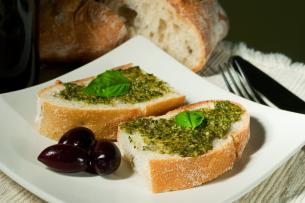Little did most kitchens put attention to is on how a touch of pesto extremely modifies dish. Yes, there is an Italian sauce called pesto; traditionally made by hand with a mortar and wooden pestle in the best natural ingredients without preservatives and food coloring.
This genuine Italian specialty
spread and sauce is known for its old-country flavor and aroma. So, what is pesto made of
and what makes it hearty? Perhaps a little background will help
explain.
Pesto sauces and spreads have been
used in Italian cuisines since the times of the Romans. The practice of this
traditional paste that is typically made of basil, garlic, pine
nuts, Italian olive oil and Parmesan cheese, has its origin from Genoa in the Italian province
of Liguria. This favorite is
best used as spread on breads, pizza sauce or pasta, and as a final flavor touch for soup.
In the preparation of pesto spreads
and sauces, there is significance in
using only the freshest of ingredients because pesto is not cooked. Chefs of today’s
generation can choose from either the classic-by-hand method the modern blender method
of preparing pesto. The combined culture and fresh character in a pesto has
made it another hearty European tradition we all can embrace.
Taste Profile
The basic ingredient of
pesto that is common to all pesto recipes
are fresh basil leaves, cheese, pine nuts, garlic and Italian olive oil. The fresh taste and
sharpness of basil is maintained in mortar and pestle. Pesto flavors are often very
strong therefore it must be used sparingly with care. A small amount is what is
usually needed to go the way. Flavors are the taste of
combined basil from Liguria and Pignoli from the Italian hills that ranges from
light and flavorful to spicy.
Cooking Suggestion
Pesto spread is perfect when spread
evenly on baked pastry to the edge,s as a grilling sauce, burger
topping, pizza sauce for pasta, on cooked meats, and in soups. Pesto spreads may be tossed with
spaghetti, macaroni, trofie or the classic Lingurian pasta of Genoa. Traditionally, pesto is
famous in sandwiches and pizza. Learn how to make fresh and flavorful pesto in very pesto for your own tantalizing recipes.
 |
| 10 Great Ways to Use Pesto |
Storing Pesto
Pesto is valued for its texture
and taste and must be stored properly for its many wonderful gourmet uses in
enhancing food flavors and invigorating recipes. Store your pesto in
a jar and keep it inside the refrigerator. In preserving homemade or
store-brought pesto, pour olive oil over the
pesto to seal it from oxygen and to control it from getting spoiled. The fragrance or aroma and
flavor of a homemade pesto are on top when stored at room temperature. Once
opened, be sure to keep it.